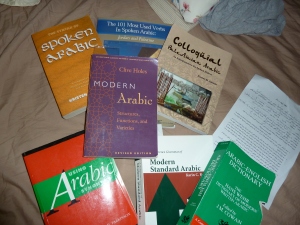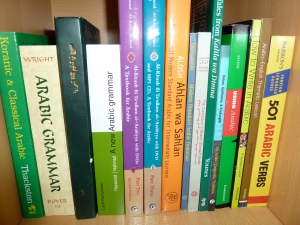I (Phillip) thought it would be fun to write a brief post about studying Arabic here so far.

I haven’t begun official study yet (at the University, or at CGE), but I have already had lots of conversational practice.
Linguistically, Arabic exists as a rather broad continuum. It is spoken natively in countries from Mauritania and Morocco in the West, through North Africa (Algeria, Tunisia, Libya), North/South Sudan, on into the Middle East proper — Egypt, Jordan, Palestine, Lebanon, Syria, Iraq, Saudi Arabia, Yemen, Qatar, Oman, Bahrain, The United Arab Emirates, and Kuwait. It is also spoken in a number of countries where it is not the dominant language throughout northern Africa and on into Asia. Needless to say, it stretches over a vast geographic area and is spoken by an estimated 250,000,000 native speakers.
Everyone from scholars of Arabic to the native speaker refers to the spoken variety of Arabic as “3aamiyah,” which means something like “having to do with everyone, the public.” Though everyone refers to what they speak as 3aamiyah, the dialects differ substantially depending on the geographic region, as well as a whole host of social and religious factors.
The formal, written variety of Arabic is relatively stable and uniform, and is referred to as “FusHaa,” or “most eloquent.” Arabs tend to refer to everything written, from Newspapers to the Qur’an as “FusHaa,” whereas scholars of Arabic tend to draw a line between CLA (Classical Literary Arabic) and MSA (Modern Standard Arabic). There are certainly subdivisions within these groupings, but as broad categories they are helpful.

The two varieties, FusHaa and 3aamiyah, are two ends on a linguistic continuum, from most formal to least formal. FusHaa tends to be used only in formal writing, news broadcasts, political speeches, etc. 3aamiyah is the language of the household, the marketplace, and dialogue between friends. Before the 19th century, there existed a much larger gap between the two varieties, but thanks to broadened education, as well as Television/Internet, more and more people are exposed to FusHaa, and, for that matter, to each other’s dialects. The resulting situation is incredibly fascinating, and equally complex.
When one goes to the Mosque (or church), one reads the Qur’an the most formally. The text is fully pointed (the Arabic alphabet contains 28 consonants, with two, the w and y functioning as ‘semi-vowels,’ but most vowels are not printed in writing) to ensure correct pronunciation and interpretation. The Qur’an is, according to Muslim belief, the very words of Allah communicated to Muhammad through Jibril (Gabriel). When news reporters or politicians speak, they tend to use FusHaa, but with fewer of the nuanced markings pronounced. Interestingly, speakers in many areas where the dialect is distinct and prestigious, like in Egypt, have begun to allow dialectical pronunciations, word choices, etc. bleed through into formal contexts. In Egypt, for example, the most characteristic phonological distinctiveness of the dialect is the pronunciation of the ‘j’ as a ‘g.’ If you listen to much of the Egyptian news, political speeches, etc., you will hear this throughout. Different words also have slightly different meanings in each region, and this shows through even in their usage in formal contexts (like “MuHeet,” which in Africa means “Sea, Ocean,” but in the Middle East means “Environment”).
At the informal level, again thanks to the internet, television, and also due to frequent travel and refugee situations, inter-dialectic communication is common. The resulting situation is that many native speakers can adjust their 3aamiyah depending on the background of their dialogue partner. I experienced this recently as I spoke with two Jordanians, two Egyptians, and an Iraqi. I heard the Egyptians using “bidd,” the modal used in the Levant for “to want,” instead of their native “3aawiz.” The Iraqi would in turn pronounce his ‘j’ as a ‘g’ to accommodate Egyptian usage. As I learn more and more words from various dialects, I am finding myself more and more able to make adjustments in my speech depending on the person with whom I am speaking!
Some of the phonological differences include:
q in FusHaa becomes ‘ (a glottal stop) in most Levantine city speakers, as well as most speakers from Cairo, whereas it is pronounced ‘g’ by most Bedouin, most people who live in smaller villages, Gulf speakers, and western North Africa. So, the word “Qaal,” “He said,” is pronounced variously as: ‘aal in the cities of the Levant; gaal in rural areas, the Gulf, and western North Africa; sometimes either kaal or qaal in bedouin pronunciation.
‘th’ in FusHaa becomes ‘t’ or ‘s’ depending on the word in 3aamiyah. This is common among most dialects, though many bedouin dialects have maintained the FusHaa pronunciation.
Another interesting case is the letter Daad. In classical tradition, it is pronounced as an emphatic counterpart to daal. In Gulf speech, however, it was analyzed differently, and it merged with Dhad, emphatic lateral counterpart to dhal. A hint at the complex background of this particular letter is detectable in a nickname for Arabic, “lughat al-Daad,” “The Language of the Daad.”
Well, I could write on for hours, but I supposed the one or two of you who managed to stay awake to the end of this post would prefer I stop there. Rachel will be posting again soon, so please don’t let this particular post chase you away from the blog for good!
الى لقاء
Leave a reply to Mack Hollaway Cancel reply